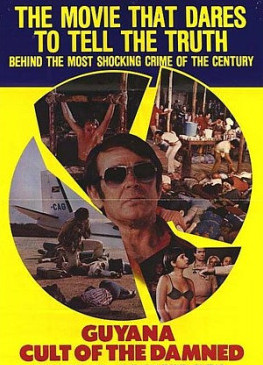Tuesday, January 29, 1980
GUYANA - CULT OF THE DAMNED. Co-written by Carlos Valdemar. Music by Nelson Riddle. Co-written, produced and directed by René Cardona Jr. Running time: 88 minutes. Restricted entertainment with the B.C. Classifier's warning: “some disturbing scenes of death and violence.”
IN MID-NOVEMBER 1978, in a remote corner of the Guyanese jungle, California senator Leo Ryan, three American newsmen and nearly 1,000 followers of the Reverend Jim Jones died. The incident, a mixture of murder and suicide, became known as “the Jonestown massacre.”
After the initial shock, there were many questions. Who were these people? What were they doing in South America? How could parents murder their own children? How could such a terrible thing happen?
After the initial shock, there was no doubt about it. Here was the raw material for a powerful, moving human drama.
Guyana - Cult of the Damned isn't it. A dull, uninspired potboiler, it was written, produced and directed by René Cardona Jr., a filmmaker who feeds off front page headlines.
Remember Survive!, the 1976 Mexican-made exploitation picture based on the story of the Andes cannibals? It's on TV tonight [1980]. Cardona Jr. produced it for his father, writer-director René Cardona Sr.
In common with Survive!, Guyana is low-budget, low-grade sensationalism, the sort of first-draft filmmaking that has neither courage nor conviction. It answers none of the questions raised by the real-life massacre.
Instead, it manages to suggest a number of questions of its own.
If, as the ads say, this is “the movie that dares to tell the truth,” why have so many of the names been changed?
In Cardona's film a Rev. Jim Johnson (Stuart Whitman) leads his San Francisco flock to Johnsontown, Guyana. It is the visit of a congressman named Leo Ryan (Gene Barry) that triggers the ultimate tragedy.
If Johnson is, as the movie's narrator says, a charismatic figure capable of hypnotizing people with the sound of his voice, why hire an old pug — Whitman is a former boxer — to play the role? The man would have trouble selling used cars, let alone promised lands.
If the film is, in fact, a fictionalization of the Jonestown incident, why pretend that it is some kind of docu-drama? Could it be that Cardona was in such a rush to get his cynical little schlocker into theatres that he couldn't be bothered writing a script with connected scenes or dramatic integrity?
After the initial shock, we realized that Jim Jones bore responsibility for an appalling waste of human lives. Guyana - Cult of the Damned is just an appalling waste of time.
The above is a restored version of a Province review by Michael Walsh originally published in 1980. For additional information on this archived material, please visit my FAQ.
Afterword: The son of the prolific Mexican filmmaker René Cardona (1905-1988), René Cardona Jr. joined the family business early on, acting in his father’s films from the age of nine. He was 25 in 1964 when he directed his first feature. Twelve years later, he broke through to the international audience with his 52nd picture, the English-language Tinorera: Killer Shark. Made to take advantage of the Jaws-generated
In the above review, I posed a number of questions. Another worth considering is why so many name actors — Stuart Whitman, Gene Barry, John Ireland, Joseph Cotten, Yvonne De Carlo, Bradford Dillman and Jennifer Ashley — signed on to the project. The short answer is: a paycheque. In the youth-obsessed Hollywood of the late 1970s, those familiar names were past their best-before dates for major movie roles.
A second factor was the enthusiasm that European producers had for Hollywood stars. When the Mexico-Italy co-production treaty came into force in 1974, Cardona Jr. had more money for budgets, and a larger pool of talent from which to draw. It didn’t hurt that Guyana: Cult of the Damned was shot in Acapulco, a tropical resort town significantly closer to Los Angeles than Rome. For actor Whitman, it was the first of three pictures he’d make for Cardona Jr. He returned to Mexico for 1980’s Under Siege and Treasure of the Amazon (1985).
Cult viewing: Included in today’s Reeling Back movie package are 1979’s Guyana - Cult of the Damned; The Deceivers (1988); Ticket to Heaven (1981) and To the Devil a Daughter (1976).
